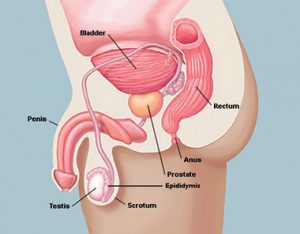 Testicular cancer is the most common cancer in men aged between 15 and 45. However, it is a rare cancer and accounts for only about 1% of all cancers in men. In Northern Ireland, around 65 men are diagnosed each year, and on average, only one death per year. Testicular cancer is highly treatable if detected early. That is why it’s so important for men to check themselves regularly.
Testicular cancer is the most common cancer in men aged between 15 and 45. However, it is a rare cancer and accounts for only about 1% of all cancers in men. In Northern Ireland, around 65 men are diagnosed each year, and on average, only one death per year. Testicular cancer is highly treatable if detected early. That is why it’s so important for men to check themselves regularly.
The testicles are two oval shaped organs which form part of the male reproductive system. Testicular cancer develops when one cell in the testicles starts to multiply uncontrollably thus forming a tumour in one or both testicles. However, it is rare to develop cancer in both testicles at the same time.
 Symptoms of testicular cancer
Symptoms of testicular cancer
The most common symptom of testicular cancer is a painless hard lump in the testicle. Other symptoms may include:
- Pain and tenderness in testicles or scrotum
- Heaviness in scrotum
- A dull ache in lower abdomen (stomach), groin or back
- Build up of fluid in the scrotum
- Blood in sperm
- A change in size or shape of a testicle
Diagnosing testicular cancer
If there is cause for concern your doctor will refer you to a specialist for an ultrasound examination of the testicles and you may have bloods taken.
Causes of testicular cancer
The cause of testicular cancer is not known. The risk is increased if you had an undescended testicle or you have had testicular cancer in the past. Brothers or sons of men who have had testicular cancer are also at increased risk. There is no link between vasectomy (a surgical procedure for male sterilization) and testicular cancer.
Testicular self examination
You should check your testicles once a month from puberty onwards. Ideally, check during or after showering. Follow these guidelines to check your testicles thoroughly:
- Place the scrotum in the palm of the hand. It is common to have one testicle slightly larger or which hangs lower than the other
- Gently roll each testicle individually between the thumbs and fingers feeling for lumps, swellings or changes in firmness
- If there is a noticeable difference in size or weight between the testicles this may mean something is wrong
- There is a soft tube at the top and back of each testicle called the epididymis. It may feel slightly tender. It is a normal part of the anatomy and should not be confused with an abnormal lump
The symptoms outlined above are often caused by something less serious and don’t usually mean it’s cancer. However, finding cancer early makes it more treatable and a trip to your doctor could save your life. So if in doubt get it checked out. If it’s not serious, your mind will be put at rest. You certainly won’t be wasting anyone’s time.
Treating testicular cancer
Testicular cancer is highly curable, especially if found and treated early. The exact treatment depends on the type of testicular cancer and how advanced it is. An operation to remove the affected testicle is usual. The loss of one testicle does not affect a man’s ability to have an erection or father children. An artificial testicle can be put in the scrotum to restore a normal appearance.
If you are unsure of what to do next you can talk with one of our nurses on our free and confidential support Nurseline on 0800 783 3339 (Monday, Wednesday and Friday, 9am – 1pm). You can also email us on nurseline@cancerfocusni.org.







